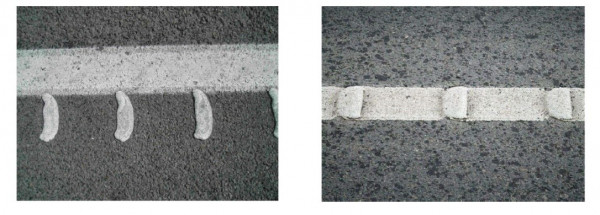Audio tactile profiled (ATP) roadmarkings, sometimes referred to as rumble strips, are long-life roadmarkings which have raised ribs or mounds oriented perpendicular to the direction of travel and spaced at regular intervals along them (Figure 2‑14). If a driver runs over an ATP marking it will provide an audible and tactile warning. Longitudinal ATP roadmarkings can be used to:
Figure 2‑14
Safety benefits:
Where centre-line and edgeline ATPs are provided, the crash reduction benefits may be less than the sum of each.
Figure 2‑14: Examples of ATP use in New Zealand

ATP roadmarkings are not appropriate for use in a transverse direction across a roadway.
The extra noise and vibration on top of road surface noise produced by vehicles travelling on an ATP roadmarking is highly dependent on road surface, vehicle type, travel speed, rib height and the spacing between ribs. The optimum ATP roadmarking dimensions have been determined by practical experiments and have proved to be suitable for use in most situations.
The raised ribs of ATP roadmarkings project above surface water on the road. This improves line delineation in wet conditions and when installed in accordance with Specification P30 also renders them more visible on wet nights.
Specification P30: high performance roadmarking
Profiled edgeline markings can also:
ATP roadmarkings are such a proven road safety measure that they are the preferred marking for rural roads of primary collector or higher on the One Network Road Classification and should be used unless there is a specific reason not to install them.
For additional detailed information refer to: